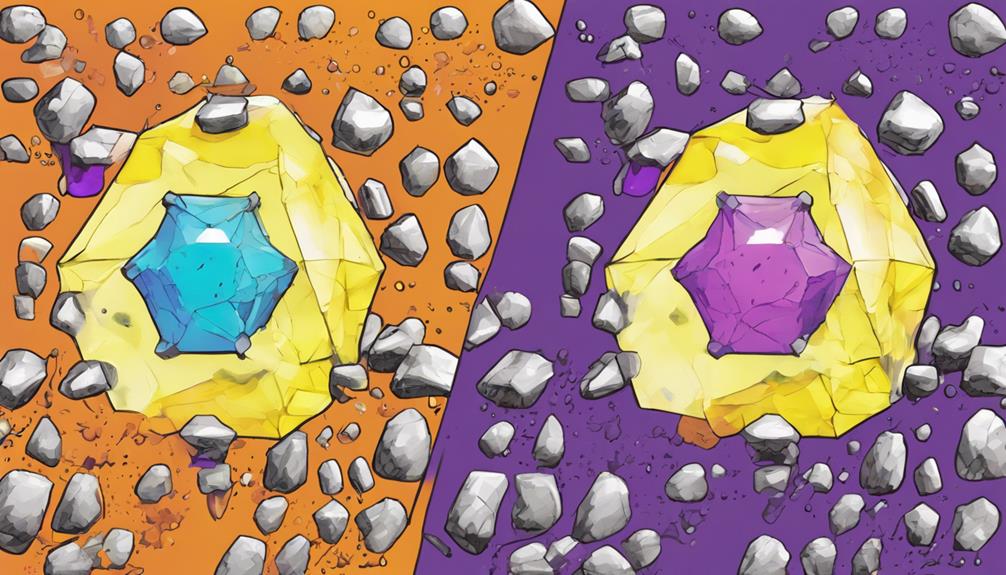You're wondering why KBr has a greater lattice energy than KCl? It's due to the size difference between the bromide and chloride ions. The larger ionic radius of bromide in KBr leads to weaker electrostatic interactions, but that's not the case for KCl. The smaller chloride ion in KCl results in stronger electrostatic interactions, which contribute to a higher lattice energy. This difference in lattice energy has a significant impact on the chemical properties of these compounds. As you explore this topic further, you'll discover more about how these energy differences shape the characteristics of ionic compounds like KCl and KBr.
Key Takeaways
- KBr does not have a greater lattice energy than KCl; in fact, KCl has a higher lattice energy due to the smaller ionic radius of Cl-.
- The smaller ionic radius of Cl- in KCl results in stronger electrostatic interactions and a higher lattice energy.
- The larger ionic radius of Br- in KBr leads to weaker electrostatic interactions and a lower lattice energy.
- The charge density of Cl- is higher due to its smaller radius, resulting in stronger ionic bonds and a more stable crystal lattice.
- The differences in lattice energies of KCl and KBr are attributed to the varying ionic radii of Cl- and Br-, not to KBr having a greater lattice energy.
Factors Affecting Lattice Energy
When you consider the factors that influence lattice energy, two key players emerge: ion charges and sizes. These factors are pivotal in understanding the energy required to separate ions in an ionic compound.
In the case of KBr and KCl, understanding lattice energy helps explain why KBr has a greater lattice energy than KCl. This is because KBr has a smaller atomic radius than KCl, resulting in a shorter distance between the positive and negative ions in the lattice structure. As a result, the electrostatic forces of attraction between the ions in KBr are stronger, leading to a greater lattice energy. Understanding how to identify lattice energy is important in predicting and comparing the stability and properties of ionic compounds. By considering the relative sizes of the ions and the overall charge of the compound, one can make informed predictions about the relative strengths of the lattice energies in different compounds.
As you explore further, you'll find that higher ion charges and smaller ion sizes lead to greater lattice energies. This means that the energy required to separate ions in an ionic compound increases when the ions have higher charges and are smaller in size.
In the context of KBr and KCl, the larger size of Br- ions in KBr compared to Cl- ions in KCl leads to a lower lattice energy in KCl. This highlights the importance of considering ion sizes and charges when predicting properties and behaviors of ionic compounds.
Ionic Radius and Charge

You'll find that the ionic radius of Cl- in KCl is much smaller than that of Br- in KBr, which has a significant impact on the electrostatic interactions between ions in these compounds. This size difference affects the strength of the ionic bonds, with the smaller Cl- ions resulting in stronger electrostatic interactions in KCl. In contrast, the larger Br- ions in KBr lead to weaker electrostatic interactions.
The charge density of the ions also plays an essential role in determining the strength of these ionic bonds. The smaller ionic radius of Cl- means it has a higher charge density, resulting in stronger electrostatic interactions. On the other hand, the larger ionic radius of Br- leads to a lower charge density, resulting in weaker electrostatic interactions.
In the context of lattice energy, these differences in ionic radius and charge density have a notable impact. The weaker electrostatic interactions in KBr result in a lower lattice energy compared to KCl. This highlights the importance of considering the ionic radius and charge density when comparing the lattice energies of different compounds like KBr and KCl.
Comparing KCl and KBr

Comparing KCl and KBr reveals distinct differences in their lattice energies, which stem from the varying ionic radii of Cl- and Br-.
You might expect that since Br- has a larger ionic radius, it would result in stronger electrostatic interactions and a higher lattice energy. However, the opposite is true. The larger ionic radius of Br- in KBr actually leads to weaker electrostatic interactions and a lower lattice energy compared to KCl.
This difference in lattice energies has a significant impact on the properties and stability of these ionic compounds.
You'll notice that KCl has a higher melting point and is less soluble than KBr. This is because the stronger electrostatic interactions in KCl require more energy to overcome, resulting in a more stable crystal formation.
Understanding the relationship between ionic radius and lattice energy helps you predict these properties and stability in other ionic compounds. By recognizing how these factors influence lattice energy, you can better comprehend the unique characteristics of KCl and KBr.
Lattice Energy of KCl

As you explore the lattice energy of KCl, you'll notice that the ionic radius of Cl- plays a significant role.
You'll see how the smaller size of Cl- ions contributes to stronger electrostatic interactions, resulting in a higher lattice energy.
Now, let's examine these points more closely to understand the factors that influence KCl's lattice energy.
Ionic Radius Effects
The smaller ionic radius of Cl- in KCl enables stronger electrostatic forces, resulting in a higher lattice energy compared to KBr. This is because a smaller ionic radius means the negatively charged Cl- ions are packed more tightly together, allowing for stronger electrostatic interactions between the ions.
As a result, the lattice energy of KCl is higher than that of KBr. You can think of it this way: the higher charge density of Cl- ions in KCl contributes to more stable crystal lattice structures, which in turn increases the lattice energy.
In contrast, the larger ionic radius of Br- in KBr leads to weaker electrostatic interactions and a lower lattice energy. Understanding the impact of ionic radius on lattice energy helps explain the differences in properties between KCl and KBr.
Electrostatic Interactions
You'll find that the lattice energy of KCl is greatly influenced by the strong electrostatic interactions between its ions, which are fueled by the high charge density of Cl- ions. This is because the smaller ionic radius of Cl- in KCl results in higher charge density and stronger electrostatic interactions.
As a result, the lattice energy of KCl is higher compared to KBr, indicating a more stable crystal lattice structure. This difference in lattice energies affects the solubility, melting points, and crystal formation of these compounds.
When you consider the crystal lattice structure of KCl, you'll see that the strong electrostatic interactions between ions lead to a more rigid and stable structure. This, in turn, affects the physical properties of KCl, such as its solubility and melting points.
In contrast, KBr has a lower lattice energy due to the larger ionic radius of Br-, resulting in weaker electrostatic interactions and a less stable crystal lattice structure. Understanding these electrostatic interactions and their impact on lattice energy is essential in explaining the differences between KCl and KBr.
Lattice Energy of KBr

As you explore the lattice energy of KBr, you'll notice that the ionic radius of Br- ions plays a significant role.
You'll find that the larger size of these ions leads to weaker electrostatic interactions, which in turn affect the lattice energy of KBr compared to KCl.
Ionic Radius Effect
The larger ionic size of bromide ions in KBr, compared to chloride ions in KCl, significantly affects its lattice energy. You might wonder how this variation in ionic size impacts the lattice energy of these two compounds.
Here are some key points to bear in mind:
- The larger ionic size of Br- leads to a lower charge density, resulting in weaker electrostatic interactions within the crystal lattice structure of KBr. This, in turn, contributes to a lower lattice energy in KBr compared to KCl.
- The smaller ionic size of Cl- in KCl, on the other hand, results in stronger electrostatic interactions, leading to a higher lattice energy.
It's essential to acknowledge that the ionic size plays a significant role in determining the lattice energy of these compounds. As you explore the differences between KBr and KCl, keep in mind how the ionic size of Br- and Cl- influences the electrostatic interactions and, ultimately, the lattice energy of these two substances.
Electrostatic Interactions Role
When exploring the lattice energy of KBr, it's fundamental to recognize that the weaker electrostatic interactions between potassium ions and bromide ions greatly contribute to its lower lattice energy compared to KCl.
This is because the larger ionic radius of Br- results in a lower charge density, leading to weaker electrostatic interactions. As a result, the ionic bonding in KBr is less strong, which affects its lattice energy.
In contrast, the smaller ionic radius of Cl- in KCl leads to a higher charge density, resulting in stronger electrostatic interactions and a higher lattice energy. This difference in lattice energies has a significant impact on the stability and properties of KBr and KCl compounds.
You can see that the weaker electrostatic interactions in KBr play a pivotal role in its lower lattice energy. By understanding these electrostatic interactions, you'll gain insight into why KBr has a different lattice energy than KCl.
Lattice Energy Comparison
You'll find that the lattice energy of KBr is greatly influenced by the size and charge of its constituent ions, particularly the bromide ion. This is because the lattice energy is directly related to the electrostatic interactions between the ions in the crystal lattice structure. The larger ionic radius of Br- in KBr results in weaker electrostatic interactions, which in turn lead to a lower lattice energy compared to KCl.
Here are some key points to keep in mind:
** The charges and sizes of ions play a pivotal role in determining lattice energy, with smaller ions and higher charges leading to higher lattice energies.
The differences in lattice energies of KCl and KBr can help predict their solubility, melting points, and crystal lattice structures**.
** Understanding the lattice energy of KBr is crucial to understanding its physical and chemical properties, and how they differ from those of KCl.
Significance in Chemical Properties

Comparing the lattice energies of KBr and KCl reveals significant differences in their chemical properties, which directly impact their behaviors in various reactions and applications. You'll notice that KCl exhibits higher solubility in water and a higher melting point, which can be attributed to its greater lattice strength.
On the other hand, KBr's lower lattice strength results in weaker electrostatic interactions, leading to a less stable crystal lattice structure. This difference in lattice strength also affects their crystal formation; you're more likely to get larger crystals with KBr due to its lower lattice strength.
Understanding the lattice energy differences between KBr and KCl is important in predicting their properties and behaviors. The larger ionic radius of Br- ions in KBr contributes to its lower lattice energy, which in turn affects its chemical properties. By recognizing these differences, you can better comprehend how KBr and KCl react in various situations, making it essential to take into account lattice energy when working with these compounds.
Lattice Energy Definition and Formula

The lattice energy of an ionic compound, like KBr or KCl, refers to the energy required to separate one mole of it into its gaseous ions, which is an important concept in understanding the compounds' properties and behaviors. As you explore into the world of ionic compounds, you'll realize that lattice energy plays a significant role in determining their stability and properties.
Here are some key takeaways to keep in mind:
- Lattice energy is calculated using the Born-Lande equation, which takes into account the charges and sizes of the ions.
- Higher charges and smaller ion sizes lead to greater lattice energies, which is why KBr has a higher lattice energy than KCl.
- Understanding lattice energy is essential for predicting the stability and properties of ionic compounds like KCl and KBr.
Now that you have a solid grasp of lattice energy, you're ready to explore how it affects the properties of KBr and KCl. By understanding the factors that influence lattice energy, you'll be able to better comprehend why KBr has a greater lattice energy than KCl.
Calculating Lattice Energy Values

To calculate the lattice energy values of KBr and KCl, plug in the specific ion charges and sizes into the Born-Lande equation. You'll need to know the charges of the potassium (K+), bromide (Br-), and chloride (Cl-) ions, as well as their respective sizes.
Remember, lattice energy is the energy required to separate one mole of an ionic compound into its gaseous ions. The calculation takes into account the factors that influence lattice energy, including ion charge and ion size.
As you perform the calculation, you'll find that the lattice energy of KBr is greater than that of KCl. This is because the larger size of the bromide ion (Br-) compared to the chloride ion (Cl-) affects the lattice energy. The smaller the ion size and the higher the ion charge, the greater the lattice energy.
Understanding Ionic Compounds

You're about to immerse yourself in the world of ionic compounds, where the intricate dance of ion sizes and charges determines their properties and behavior. To truly understand why KBr has a greater lattice energy than KCl, you need to grasp the fundamentals of ionic compounds.
Here are three key takeaways to get you started:
- Ion size matters: The larger ionic radius of Br- compared to Cl- affects the lattice energy of KBr and KCl.
- Charge density is key: The higher charge density of Cl- leads to stronger electrostatic interactions and higher lattice energy in KCl.
- Electrostatic interactions impact properties: The difference in lattice energies influences the solubility, melting point, and crystal formation properties of KCl and KBr.
Understanding the interplay between ion size, charge density, and electrostatic interactions is essential in predicting the stability and behavior of ionic compounds like KCl and KBr. By recognizing how these factors impact lattice energy, you'll gain a deeper appreciation for the unique properties of each compound.
Frequently Asked Questions
Does KBR or KCL Have Higher Lattice Energy?
You're wondering which one has higher lattice energy, KBr or KCl. Surprisingly, it's not KBr. Actually, KCl has higher lattice energy due to the stronger electrostatic interactions from Cl-'s smaller ionic radius.
Which Has More Lattice Energy KCL or Rbbr?
Imagine yourself amidst a sea of ions, where size matters. You're comparing KCl and RbBr, and you'll find that RbBr's larger Rb+ ions dilute the electrostatic attraction, resulting in a lower lattice energy than KCl.
What Is the Lattice Energy of Kbr?
You're wondering what the lattice energy of KBr is. Well, lattice energy measures the energy released when ions combine to form a crystal lattice. For KBr, it's the energy required to separate potassium and bromide ions, and it's a significant value that affects the compound's properties.
Why Does Nacl Have a Higher Lattice Energy Than Kcl?
You find that NaCl has a higher lattice energy than KCl because the smaller size of Na+ and Cl- ions results in shorter interionic distances, leading to stronger electrostatic attractions and a more stable ionic bond.
Conclusion
As you now know, KBr's lattice energy trumps KCl's, and it's not just a coincidence.
The key lies in the ionic radius and charge, which dictate the strength of ionic bonds.
KBr's larger bromide ion means weaker bonds, yet its lattice energy is higher.
This puzzle pieces together when you consider the charge: potassium's positive charge wins over the larger bromide ion, resulting in a tighter grip and higher lattice energy.
It's a delicate dance of ions, where size and charge take center stage.










